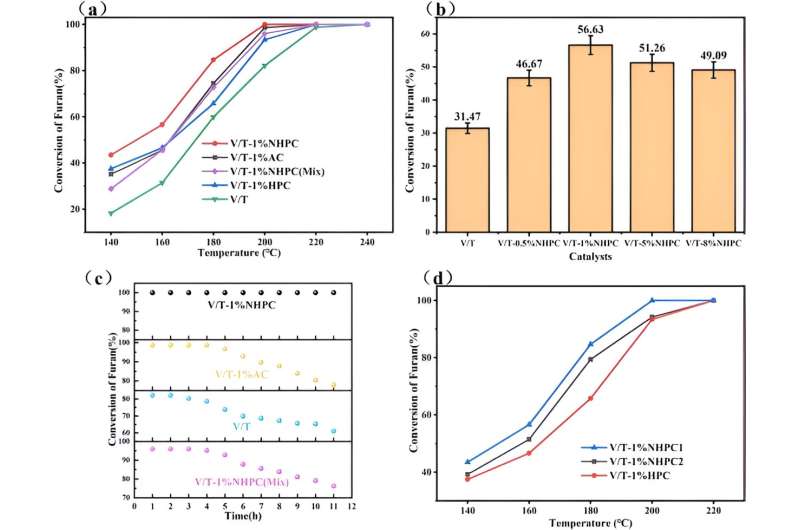This article has been reviewed according to Science X's editorial process and policies. Editors have highlighted the following attributes while ensuring the content's credibility:
fact-checked
proofread
Catalyst combines vanadium-based components and nitrogen-doped biomass carbon for pollutant removal

Polychlorinated dibenzo-p-dioxins and dibenzofurans are dangerous pollutants due to their carcinogenicity and persistence in the environment. Traditional catalytic oxidation methods for their removal face challenges like high cost and inefficiency at lower temperatures.
Research has shown that using carbon materials, such as carbon nanotubes and active carbons, improves catalytic performance by enhancing the adsorption and distribution of active sites. However, their application is limited by costs and maintenance issues. N-doped carbon materials, derived from biomass, offer a promising alternative with their high surface area and porosity, potentially lowering operational temperatures and increasing efficiency.
In a new study published in Waste Disposal & Sustainable Energy, researchers from Zhejiang University introduce a catalyst combining vanadium-based components and nitrogen-doped biomass carbon (NHPC).
This development significantly enhances the low-temperature degradation activity of furan, offering a novel solution for the efficient breakdown of persistent organic pollutants, marking a significant step forward in environmental remediation efforts.
In this study, researchers developed a series of vanadium-based catalysts, and their catalytic performances were significantly enhanced by nitrogen-doped hierarchical porous carbon (NHPC) derived from biomass. This enhancement led to a marked improvement in the degradation of furan, a persistent organic pollutant, at lower temperatures than previously possible.
The NHPC's introduction into the catalyst structure facilitated an increase in active sites and improved the homogeneous distribution of vanadium oxide phases, which are crucial for the catalytic process. At 150°C, the modified catalyst achieved 50% furan conversion, a significant improvement over traditional catalysts, with complete conversion occurring at 200°C.
Dr. Minghui Tang, a leading researcher in the study, states, "This breakthrough not only enhances the efficiency of furan degradation at significantly lower temperatures but also opens new pathways for sustainable environmental remediation techniques."
The application of N-doped Hierarchical Porous Carbon (NHPC) in catalysts marks a pivotal advancement in environmental technology, offering a low-temperature, cost-effective method for hazardous pollutant removal. This innovation not only sets a new standard for pollution control but also underscores the potential of biomass-derived carbon materials in catalytic degradation, enhancing pollutant degradation efficiency and fostering sustainable environmental protection solutions.
More information: Ling Wang et al, Enhancing mechanisms of N-doped biomass carbon on the vanadium-based catalyst for furan degradation at low temperature, Waste Disposal & Sustainable Energy (2023). DOI: 10.1007/s42768-023-00172-0
Provided by TranSpread





















